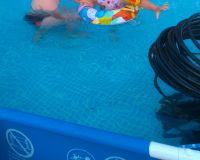Unfortunately, I can not answer this question. For me, on the square, I have 3 eco-pea coal boilers, one at home and two in farm buildings that work all year round, and to be honest, no one pays attention to the fuel consumption. It is supposed to burn in them already. I am missing coal, I take a forklift and bring another pallet under the boiler room. It may not be economical, but I do not have time to stand by the stove. If there is another fuel, I will change something in those boilers in farm buildings. One of them is connected to a swimming pool. At home, the boiler goes on PID controllers, measures the temperature of the heat and the temperature of the exhaust gases and selects the dosage itself. It can be set like traditional feeding, but I have not tried it until today.
The only problem that comes with connecting it for the first time is to circulate in this heater. I have about 15m from the pool from the boiler room. I fill these tubes with water and then connect one end to the boiler. I'm just dropping the water and then connect the other end. I just have it easier because halfway to the pool I have two connectors because sometimes when the truck enters the square I have to disconnect it because as you know too many of these tubes would not be left. As a load, I use a field stone with 10kg lying on this loop. Its advantage is that it does not get dirty. And it does not absorb water. In the past, Grandma used it to pickled cabbage in a barrel to press it.

I was also thinking how to separate the pool water circuit from the water circulation in the boiler. At first it was supposed to be done using a heat exchanger, but I did not know whether it would be possible to buy a plate heat exchanger for testing. Another thought is a boiler that I had with a small simple leak to weld. Well, in the end, I have such a thought with these pipes and it's ok. Of course, the problem arose how to connect to the boiler non-invasively. I did it a little professionally because it was only for the test but this year it will be the same because the connectors were at the boiler. The power supply has been connected to the cork in which the additional thermometer is screwed into the boiler. For me it was not there for it there was a 3/4 inch plug behind it, I put in a circulating pump and you know it to the pool. The return was again connected unusually because the valve for filling the water in the boiler was also 3/4 inch. So it took place without interfering in the pipes of the CO installation which in my case are in the case of 6/4 inch boilers and it would be difficult. Anyway, as I wrote it was made to be as simple as possible because only for a try. This year I will not change anything. For this I recommend this solution to everyone. It was nice once when it was raining in the evening it was quite chilly and we warmly bathed our family in a warm pool and then quickly home.



